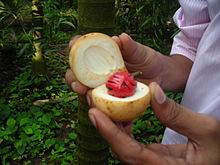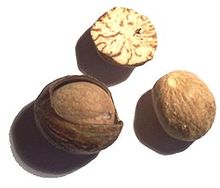 |
|
|
|
|
| Cuisines | Herbal | Spice | Curry | Yeast | Recipe | ||||||
|
Nutmeg The nutmeg tree is any of several species of trees in genus Myristica. The most important commercial species is Myristica fragrans, an evergreen tree indigenous to the Banda Islands in the Moluccas (or Spice Islands) of Indonesia. The nutmeg tree is important for two spices derived from the fruit: nutmeg and mace. Nutmeg is the seed of the tree, roughly egg-shaped and about 20 to 30 mm (0.8 to 1.2 in) long and 15 to 18 mm (0.6 to 0.7 in) wide, and weighing between 5 and 10 g (0.2 and 0.4 oz) dried, while mace is the dried "lacy" reddish covering or aril of the seed. The first harvest of nutmeg trees takes place 7–9 years after planting, and the trees reach full production after 20 years. Nutmeg is usually used in powdered form. This is the only tropical fruit that is the source of two different spices. Several other commercial products are also produced from the trees, including essential oils, extracted oleoresins, and nutmeg butter (see below). The common or fragrant nutmeg, Myristica fragrans, native to the Banda Islands of Indonesia, is also grown in Penang Island in Malaysia and the Caribbean, especially in Grenada. It also grows in Kerala, a state in southern India. Other species of nutmeg include Papuan nutmeg M. argentea from New Guinea, and Bombay nutmeg M. malabarica from India, called jaiphal in Hindi; both are used as adulterants of M. fragrans products. Botany and cultivationNutmeg is a dioecious plant which is propagated sexually and asexually, the latter being the standard. Sexual propagation by seedling yields 50% male seedlings, which are unproductive. As there is no reliable method of determining plant sex before flowering in the sixth to eighth year, and sexual propagation bears inconsistent yields, grafting is the preferred method of propagation. Epicotyl grafting, approach grafting and patch budding have proved successful, epicotyl grafting being the most widely adopted standard. Air-layering, or marcotting, is an alternative, though not preferred, method, because of its low (35-40%) success rate. Culinary uses Nutmeg and mace have similar sensory qualities, with nutmeg having a slightly sweeter and mace a more delicate flavour. Mace is often preferred in light dishes for the bright orange, saffron-like hue it imparts. Nutmeg is used for flavouring many dishes, usually in ground or grated form, and is best grated fresh in a nutmeg grater. In Penang cuisine, dried, shredded nutmeg rind with sugar coating is used as toppings on the uniquely Penang ais kacang. Nutmeg rind is also blended (creating a fresh, green, tangy taste and white colour juice) or boiled (resulting in a much sweeter and brown juice) to make iced nutmeg juice. In Indian cuisine, nutmeg is used in many sweet as well as savoury dishes (predominantly in Mughlai cuisine). It is also added in small quantities as a medicine for infants. It may also be used in small quantities in garam masala. Ground nutmeg is also smoked in India. In Middle Eastern cuisine, ground nutmeg is often used as a spice for savoury dishes. In originally European cuisine, nutmeg and mace are used especially in potato dishes and in processed meat products; they are also used in soups, sauces, and baked goods. In Dutch cuisine, nutmeg is added to vegetables such as Brussels sprouts, cauliflower, and string beans. Nutmeg is a traditional ingredient in mulled cider, mulled wine, and eggnog. Japanese varieties of curry powder include nutmeg as an ingredient. In the Caribbean, nutmeg is often used in drinks such as the Bushwacker, Painkiller, and Barbados rum punch. Typically, it is just a sprinkle on the top of the drink. The pericarp (fruit/pod) is used in Grenada and also in Indonesia to make jam, or is finely sliced, cooked with sugar, and crystallised to make a fragrant candy. Medical research One study has shown that the compound macelignan isolated from Myristica fragrans (Myristicaceae) may exert antimicrobial activity against Streptococcus mutans, but this is not a currently used treatment. Nutmeg has been used in medicine since at least the seventh century. In the 19th century it was used as an abortifacient, which led to numerous recorded cases of nutmeg poisoning. Although used as a folk treatment for other ailments, nutmeg has no proven medicinal value today. |











